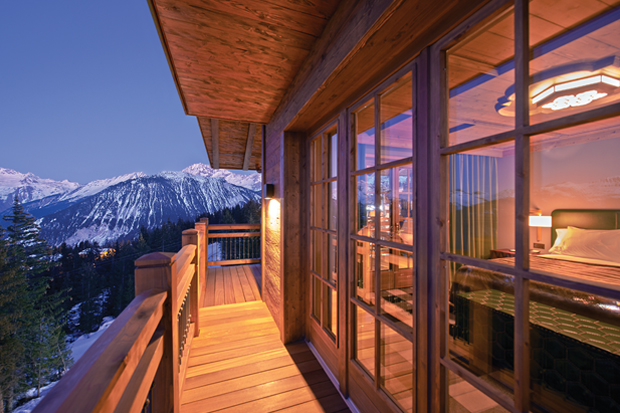Designed by the acclaimed India Mahdavi and Joseph Dirand, this stylish new Oetker collection hotel in the popular Courchevel ski resort truly turns the traditional chalet format on its head.
The disparity of specialisms and styles within this design pairing – India’s preference for colour and mixed inspiration contrasted by Joseph’s penchant for more muted, architectural tones – is integral to the success of this ambitious project, though you wouldn’t think it given the hotel’s seamless interior.
“It was a real challenge for both of us,” says India. “We had to create a fluid project, but we naturally mixed together each of our proposals. It is rare to see architects create a joint project without contrast, one which operates as an entity.”
The central premise of the pair’s design was to instil a sense of homeliness within the accommodation, yet without simply recreating the cosiness of a conventional chalet or cabin. “Rather than get into designing an imitation chalet, we thought about creating a mansion, a manor house like you find in Switzerland or the Tyrol,” Joseph explains.
“We had a choice: either to create a rustic, mountain feel, or a sophisticated and warm atmosphere. We didn’t want any false pretences; we created a home transformed over the years into a hotel.”
Comprising 33 well-appointed suites, 20 spacious double rooms, a spectacular penthouse with its own jacuzzi and private terrace, and a separate 525m² chalet, L’Apogée Courchevel’s guest rooms echo this sentiment perfectly.
Each individual suite is a chalet in miniature, steeped in soothing curved lines, arches and alcoves. An artful blend of authentic, yet highly stylish materials has been used, from pine wood and wool, to velvets, suedes and linens.
In the bathrooms, the pair opted for a two-tone mix of Fior di Bosco marble and black stone from Zimbabwe, a choice, India explains, that was designed “to give more depth, and a sense of pleasurable opulence”.
Through maintaining an organic palette – predominantly pine and blue-greens, burgundy and ginghams – throughout the accommodation, India and Joseph have been able to create a comforting sense of remove from the harsh whites of the piste.
The hotel’s public areas follow much the same principle, in the sense that the pair have maintained a sense of warmth, despite stripping the interiors back. Adjacent to the entrance lobby, for example, is a small lounge, in which guests are welcomed to read, have a drink, or simply retreat into a peaceful, welcoming space.
The Champagne bar is designed in the vein of a private club, complete with marble countertops, an inviting fireplace and soft lighting – providing the ideal evening venue.
“We wanted something informal for the bars,” explains Joseph. “We mixed club furniture with 60s- or 70s-inspired pieces, bringing together rounded shapes and adding a vintage touch. This mix of genres becomes consistent, and gives the impression of going into someone’s home to have a good time.”
In addition to its welcoming bar areas, the hotel also offers its grand signature restaurant – Le Comptoir de L’Apogée – under the supervision of the Meilleur Ouvrier de France, Franck Ferigutti. Framed by two striking staircases, this space is dominated by a wall of windows looking out over the pristine ski slopes.
In line with the hotel’s emphasis on wellbeing and comfort, the extensive spa facilities have been expertly designed for the ultimate relaxing experience. As well as its five artfully-designed treatment rooms, hairdressing salon, steam room, sauna, salt cave and plunge pool, Le Spa de L’Apogée features a fitness centre stocked with state-of-the-art gym equipment and physiotherapy rooms.
Despite the tremendous amount of work the team has put into the hotel, India and Joseph were persistently conscious that this should not be noticeable in an obvious sense, but that they would instil L’Apogée Courchevel with a sense of history.
“I would prefer people to say ‘they transformed something’ rather than ‘they created the latest trendy venue’, Joseph explains. “We all have our own culture and there are places where there is no past, but in which it feels like we already have memories, within which we thus forge experiences and rituals.”



